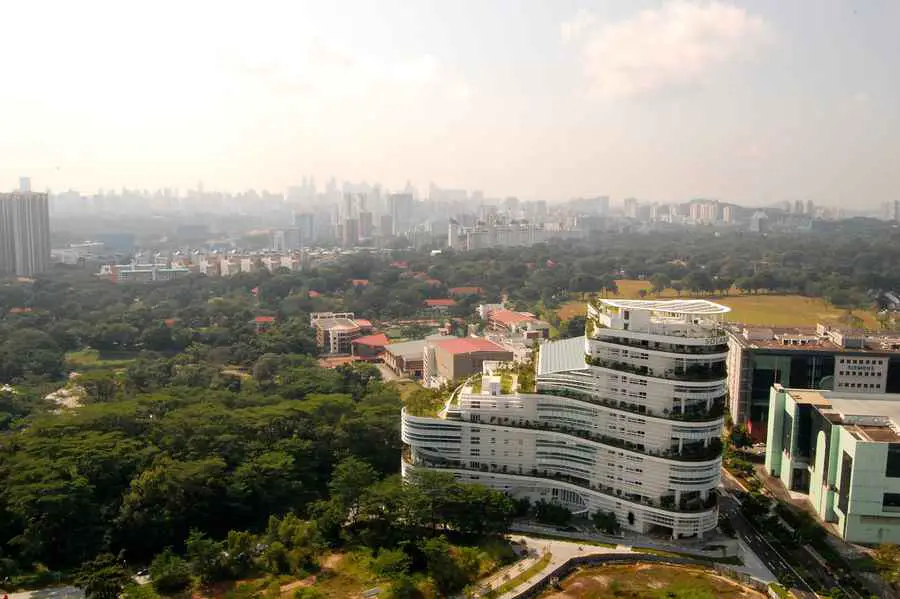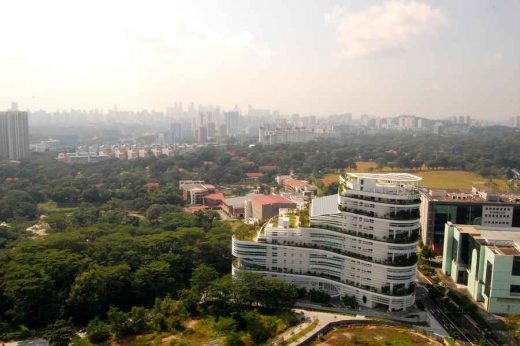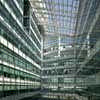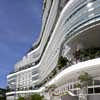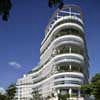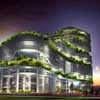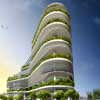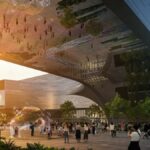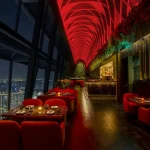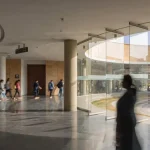Solaris, Singapore Science Centre, Architect, Images, Design, Competition, Building
Solaris Singapore Development
Southeast Asian Research Centre design by TR Hamzah Yeang architects
27 Jul + 22 Jun 2012
Solaris Fusionopolis Singapore News
Solaris Fusionopolis 2B, One North
Design: TR Hamzah and Yeang
Lubetkin Prize shortlisted building
RIBA International Awards : Winners News
2 Jun 2008
Solaris Fusionopolis
Singapore Science Centre architects : T.R. Hamzah & Yeang Sdn. Bhd.
SOLARIS is located in the research and business park in central Singapore’s one-north community. The building is a flagship project in the first phase on this locality. Fusionopolis is an R&D hub for Infocomm Technology, Media, Physical Sciences & Engineering industries which is intended to facilitate innovation and entrepreneurship in these fields. This masterplan for the visionary mixed-use development was prepared by Zaha Hadid Architects.
SOLARIS has been certified BCA GreenMark Platinum, the highest possible green certification granted by Singapore’s sustainable building benchmark (eg. LEED, GBI, GreenStar, BREEAM, etc..). The building’s overall energy consumption represents a reduction of over 36% compared to local precedents and the high performance façade has an External Thermal Transfer Value (ETTV) of 39 W/m2. With over 8,000 m2 of landscaping, Solaris also introduces vegetation which exceeds the area of the building’s original site.
SOLARIS stands as a dramatic demonstration of the possibilities inherent in an ecological approach to building design. The project is comprised of two tower blocks separated by a grand naturally-ventilated central atrium. Office floors are linked by a series of sky bridges which span the atrium at upper floors. The building will become a vibrant focal point for the one-north community through the introduction of open interactive spaces, creative use of skylights and courtyards for natural light and ventilation and a continuous spiral landscaped ramp, an extension of one-north Park across the street, which forms an ecological nexus tying together an escalating sequence roof gardens with sky terraces that interpenetrate the building’s facade. With its extensive eco-infrastructure, sustainable design features and innovative vertical green concept, Solaris strives to enhance its site’s existing ecosystems, rather than replace them.
Ecological Design Features:
Continuous Perimeter Landscaped Ramp – An uninterrupted 1.5 kilometer long ecological armature connects the adjacent one-north Park at ground level and the basement Eco-cell with the cascading sequence of roof-gardens at the building’s highest levels. The ramp has a minimum width of 3 meters. Maintenance of the spiral landscaped ramp is achieved via a parallel pathway which allows for servicing of the continuous planters without requiring access from internal tenanted spaces. The pathway also serves as a linear park in future that stretches all the way from the ground plane to the uppermost roof areas. The continuity of the landscaping is a key component of the project’s ecological design concept as it allows for fluid movement of organisms and plant species between all vegetated areas within the building, enhancing biodiversity and contributing to the overall health of these ecosystems. The ramp, with its deep overhangs and large concentrations of shade plants, is also one element in a comprehensive strategy for the ambient cooling of the building facade. This eco-infrastructure provides social, interactive and creative environments for the occupants of the building’s upper floors while balancing the inherent inorganicness of the built-form with a more organic mass.
Solar Shaft – A diagonal shaft that cuts through the upper floors of Tower A allows day-light to penetrate deep into the building’s interior. Internal lighting operates on a system of sensors which reduces energy use by automatically turning-off lights when adequate day-lighting is available. Landscaped Terraces within the solar shaft bring added quality to adjacent spaces and enhance views up into the building from the street below.
Eco-cell – Located at the building’s north-east corner where the spiral ramp meets the ground, the Eco-cell allows vegetation, daylight and natural ventilation to extend into the car-park levels below. The lowest level of the Eco-cell contains the storage tank and pump room of the rainwater recycling system.
Naturally Ventilated and Day Lit Grand Atrium – A public plaza between the two tower blocks provides a space for communal activities and creative performances. This naturally-ventilated ground floor operates as a mixed-mode (non-air conditioned) zone with an operable glass-louvered roof over the atrium providing protection from the elements while enabling full ventilation when needed. CFD (Computational Fluid Dynamics) simulations were used to analyse thermal conditions and wind-speed within the atrium. The results of these studies were used to optimize the atrium facade design to improve air flow and enhance comfort levels.
Pocket Park / Plaza – Ground level landscaping, linking to one-north Park across the street, allows for cross ventilation of the ground-floor plaza and provides a venue for social/interactive events.
Extensive Sun-Shading Louvers – The project’s climate-responsive façade design originated with analysis of the local sun-path. Singapore is at the equator and the sun-path is almost exactly east-west. Facade studies analyzing the solar-path determined the shape and depth of the sunshade louvers, which also double as light-shelves. This solar shading strategy further reduces heat transfer across the building’s low-e double-glazed perimeter facade, contributing to an extremely low External Thermal Transfer Value (ETTV) of 39 W/m2. In conjunction with the spiral landscaped ramp, sky gardens, and deep overhangs, the sunshade louvers also assist in establishing comfortable micro-climates in habitable spaces along the building’s exterior. The combined linear length of the building’s sun-shade louvers exceeds 10km.
Roof Gardens and Corner Sky Terraces – Vertical landscaping acts as a thermal buffer and creates areas for relaxation and event spaces. These extensive gardens allow building occupants to interact with nature and also offers opportunities to experience the external environment and enjoy views of the treetops of one-north Park. As it reaches each corner of the building the spiral ramp expands into generous double-volume sky terraces. Upon completion, the sum of the project’s vegetated areas will exceed the footprint of the site on which the building sits.
Rainwater Harvesting/Recycling – The building’s extensive landscaped areas are irrigated via a large-scale rainwater recycling system. Rainwater is collected from the drainage downpipes of the perimeter landscaped ramp and from the roof of tower B via Siphonic drainage. It is stored in rooftop tanks and at the lowest basement level, beneath the Eco-cell. A storage capacity of over 700 m3 allows for over five days of irrigation via recycled water between rainfalls.
GreenMark Platinum Rating – In September 2009, Solaris was awarded a Green Mark Platinum rating, the highest level of certification granted by BCA’s Green Mark, Singapore’s sustainable building benchmark.
Solaris, Singapore : Building Information
Building Name: Solaris
Site: Fusionopolis [Phase 2B]
Location: one-north, Singapore
Start of Construction: Sep 2008
Scheduled Completion: Aug 2010
Building Height: 80 m
Tower A: 15 Storeys + roof garden
Tower B: 8 Storeys + roof gardens
Total GFA: 51,274 m2
Site Area: 7,734 m2
Total Landscaped Area: 8,363 m2
Consultant Team
Client & Land Owner: JTC Corporation
Developer: Soilbuild Group Holdings Ltd
Architect of Record: CPG Consultants Pte Ltd
Architect of Design: T. R. Hamzah & Yeang Sdn Bhd
Civil & Structural Engineer: Arup Singapore Pte Ltd
Mechanical & Electrical Engineer: CPG Consultants Pte Ltd
Facade Consultant: AureconPte Ltd
Sustainability Consultant: AureconPte Ltd
Landscape Consultant: Tropical Environment Pte Ltd
Landscape Concept Consultant: T. R. Hamzah & Yeang Sdn Bhd
Contractor: Soil-Build Pte Ltd
Quantity Surveyor: PEB Consultants
T. R. Hamzah & Yeang Design Team
Principal: Dr. Ken Yeang
Project Leader: Mitchell Gelber
Senior Designer: Esther Klausen
Designer: Jan Rehders
Assistant Architect: Faizah Rahmat
3D Visualization: Vijai Kumar
Awards & Publications
First Prize – Skyrise Greenery Awards 2009
– Singapore Institute of Architects & Singapore National Parks
GreenSource Magazine – May 2009 “Ramping Up Green”
Time Based Architecture International – June 2009 “Continuous Green”
FutureArc – 1st Quarter 2010, Vol 16 ‘Solaris”
Table of Landscaped Areas
Roof Gardens: 2,987 m2
Atrium Planter Boxes: 304 m2
Eco-Cell: 83 m2
Green Ramp: 4,115 m2
Solar Shaft: 223 m2
Ground Level Landscaping: 487 m2
Green Walls: 164 m2
Total Landscaped Area: 8,363 m2
Ratio of Landscaping to GFA: 17% Green
Ratio of Landscaping to Site Area: 108% Green
Percentage of Total Landscape Area above Ground Level: 94%
Singapore Science Centre – further information
Location: Fusionopolis, Singapore
Singapore Architecture
Contemporary Singapore Architectural Projects
Singapore Architectural Designs – chronological list
Architecture Tours in Singapore by e-architect
Contemporary Architecture in Singapore – architectural selection below:
Design: Aedas
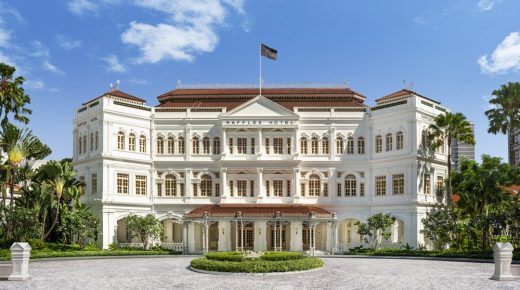
image courtesy of architecture office
Raffles Hotel
Design: Cox Architecture
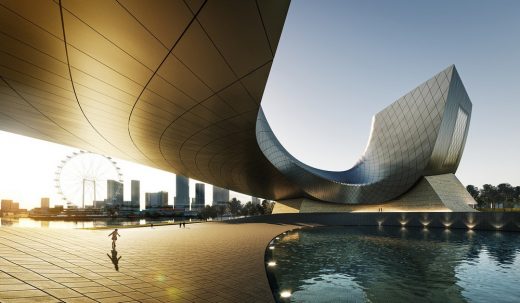
image courtesy of architects office
Founders Memorial
Rem Koolhaas Architect / OMA
Singapore Tower : iconic architecture proposal
Moshe Safdie and Associates with Aedas Architects
Marina Bay Sands
Singapore Arts Center – now called Esplanade Theatres on the Bay
Michael Wilford & Partners with DP Architects
Singapore Arts Center
Comments for the Singapore Research Centre page welcome

